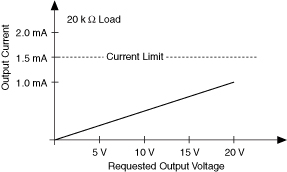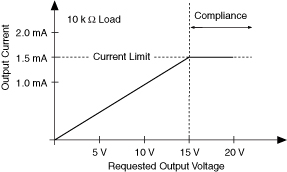What is Compliance Voltage?
Compliance voltage is the range of output voltage of a constant current power supply, over which the load regulation is within certain limits. It represents the maximum voltage a current source will reach as it attempts to produce the desired current.
The compliance voltage equals the supply voltage minus the voltage drop due to the supply’s internal resistance and usually specified at the full current of the supply. The supply voltage to the regulator input is usually higher than the compliance voltage by 1 Volt or higher depending on the type of the regulator.
A current source supplies a constant current to the load as long as the voltage is within the design limits. It cannot force the current into a load without applying the required voltage. The source adjusts the output voltage so as to provide the desired amount of current to the load. For example, to supply a current of 10mA to a 1K ohm load, the output voltage must be 10 Volts, anything less than this will not work.
If a higher resistance load is used on a power supply, the output current may never reach the supplies maximum current limit and will never enter its compliance range. For example, a 20 Volt power supply with a maximum current limit of 1.5mA may never enter the compliance range when supplying a 20KΩ load resistance.
Figure 1: Power supply unable to enter into compliance voltage range – Image Credit
However, if the load resistance is lower at 10 KΩ, the supply enters its compliance voltage range at 15V where the current is 1.5mA. After this point, increasing the voltage doesn’t increase the current and the actual voltage across the load remains at 15V once the current limit is reached.
Figure 2: Power supply in compliance voltage range – Image Credit
A practical example is the series string of LEDs powered from a single current source. Each of the LEDs will drop the forward voltage of between 1.5 and about 3.0 volts depending on the type of LED and its color. The total voltage drop from the series LEDs is the sum of each LED voltage drop. Theoretically, it looks like there is no limit on the number of LEDs that can be connected since they all have the same current passing through.
However, there is a limit due to the forward voltage drop across each of the series LEDs. The sum of the voltage drops defines the compliance voltage of the current source. The supply must reach this voltage so as to provide the required current. If there are five 2-V 20 mA LEDs, the compliance voltage will be 2 X 5 = 10 Volts, and be able to deliver 20 mA at this voltage.
In a constant current source, the current, which is independent of the load voltage, remains constant over a limited range, which is the compliance voltage range. If the voltage exceeds the compliance voltage, the current source loses its regulation and the current may damage the components such as transistors, diodes, LEDs, etc. However, it is recommended to have a reasonable range of compliance voltage to accommodate minor load variations while maintaining a constant current.

